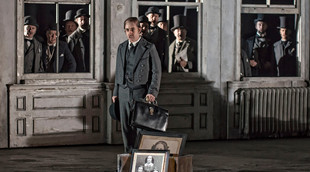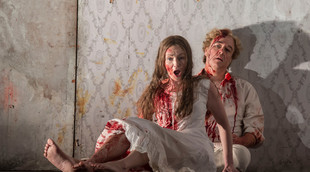 © (c) John Snelling
© (c) John Snelling
Based on Sir Walter Scott’s historical novel The Bride of Lammermoor, Donizetti’s Lucia di Lammermoor of 1835 is set in Scotland. The Ashton and Ravenswood families have a long-standing hatred of each other with the former family now owning the estate that previously belonged to the latter. The Ashtons have themselves fallen on hard times, however, leading the Master of Lammermoor Enrico to insist that his sister Lucia marry Lord Arturo Bucklaw in order to restore the family’s fortunes.
Lucia, however, has secretly fallen in love with Edgardo from the Ravenswood family, and when Enrico discovers she is in love with the ‘enemy’ he is horrified. He concocts a scheme to make it appear as if Edgardo now loves another woman, which leads Lucia to agree reluctantly to marry Arturo. Following an altercation at the signing of the marriage contract, when Edgardo turns up and confronts Lucia, she goes mad and murders Arturo on their wedding night. Enrico finally appreciates what he put Lucia through when he convinced her of Edgardo’s infidelity and forced her to marry Arturo, but it is too late to save the situation and she dies. On learning of her death, Edgardo commits suicide.
The second revival of David Alden’s 2008 production for English National Opera moves the action from the start of the eighteenth century (the opera references the death of William III in 1702) to the second half of the nineteenth century, with black and white photographs featuring in the staging. In Charles Edwards’ sets, the rooms of Lammermoor Castle are in a dilapidated state, with the feature of a proscenium arch theatre in one of them proving very revealing. One imagines that this was a richer and happier place when Enrico and Lucia were children, and that they spent hours here playing out their childish dreams and fantasies. It still has an element of theatrical magic as in Act I Edgardo suddenly appears to Lucia from behind the stage curtain, and then disappears out of sight once more at end of their encounter. In between, however, the curtain opens to break the illusion of the stage by revealing no more than a structural frame and darkness. This point is expanded on in the final act when Edgardo appears on the other side of the proscenium arch to reveal that the space is filled with nothing other than the tombs of his ancestors (here represented by black and white photographs of them).
There are a few moments when there are too many distractions as the characters play with toys, which once again symbolise childhood and innocence, but generally the amount of action is appropriate as it allows the main emotions to be rendered while hinting at other things that are going on. This balance is shown at its best in the role of the chaplain Raimondo, which is not only brilliantly sung by Clive Bayley, but acted by him in such a way that he seems to sculpt the drama around him. Raimondo, although not as brutal as Enrico, is still instrumental in persuading Lucia that Edgardo does not love her and that she should therefore marry Arturo. Here, he remains on the stage as Enrico confronts Lucia over the matter, only with his back turned, suggesting both his complicity in the affair and his attempts to turn a blind eye to Enrico’s diabolical ways. When Raimondo himself finally gains an agreement from Lucia to marry Arturo, Enrico follows this up by practically bundling her off the stage as if to suggest that it is the chaplain’s actions that have enabled the brother to behave in such an extreme manner.
On several occasions a black curtain drops to leave just a few principals in front of it, allowing us to focus entirely on them as a certain ‘theatrical’ theme is retained. The famous ‘mad scene’, in which Lucia reveals her state of mind following her murder of Arturo (a suitably ‘foppish’ Michael Colvin), has its share of successes and failures. The revelries celebrating the marriage are abruptly stopped when Raimondo declares what Lucia has done, but the moment is undermined by the dancing itself including a fight between two men so that there is no extreme contrast between the total lightness that existed before the declaration and the sheer darkness that persists after it. It is, however, clever for Lucia to be suddenly seen sitting on the proscenium stage, and in profile so that it is only when she turns around that we see how bloodied her body is. At the same time, the glass harmonica that underscores the scene is duplicated on the stage for Lucia’s companion Alisa (a splendid Sarah Pring) to play, initially at least.
However, while keeping the chorus off the stage for much of the scene allows us to focus on Lucia, it prevents us from seeing her exposing her ‘soul’ so completely in public. The character is played beautifully by Sarah Tynan who demonstrates a very sweet, clean and pure sound. Occasionally in this scene the top lines do not quite feel ephemeral enough so that her performance, which here should seem almost spiritual, remains just a little too earthbound, but overall this is an extremely committed and moving interpretation of the role.
Eleazar Rodríguez displays an immensely warm tenor as Edgardo, while revealing considerable sensitivity in his final scene. Similarly, when he confronts Lucia at the wedding he normally demonstrates a combination of hurt and anger, but here it is very much the first of these emotions that comes to the fore. The degree of understatement that derives from this complements the staging perfectly as the guests react by moving around in slow motion to end up seated. Lester Lynch, with his large and rounded baritone, is outstanding as Enrico, feeling highly brutish for the most part and yet in Act I helping us to appreciate why the character would decide to act in the way that he does. Elgan Llŷr Thomas makes much of the small part of Enrico’s retainer, Normanno, while Stuart Stratford’s excellent conducting caps what is a strong revival of one of Donizetti’s greatest creations.
By Sam Smith
Lucia di Lammermoor | 25 October – 5 December 2018 | London Coliseum
the 29 of October, 2018 | Print


Comments